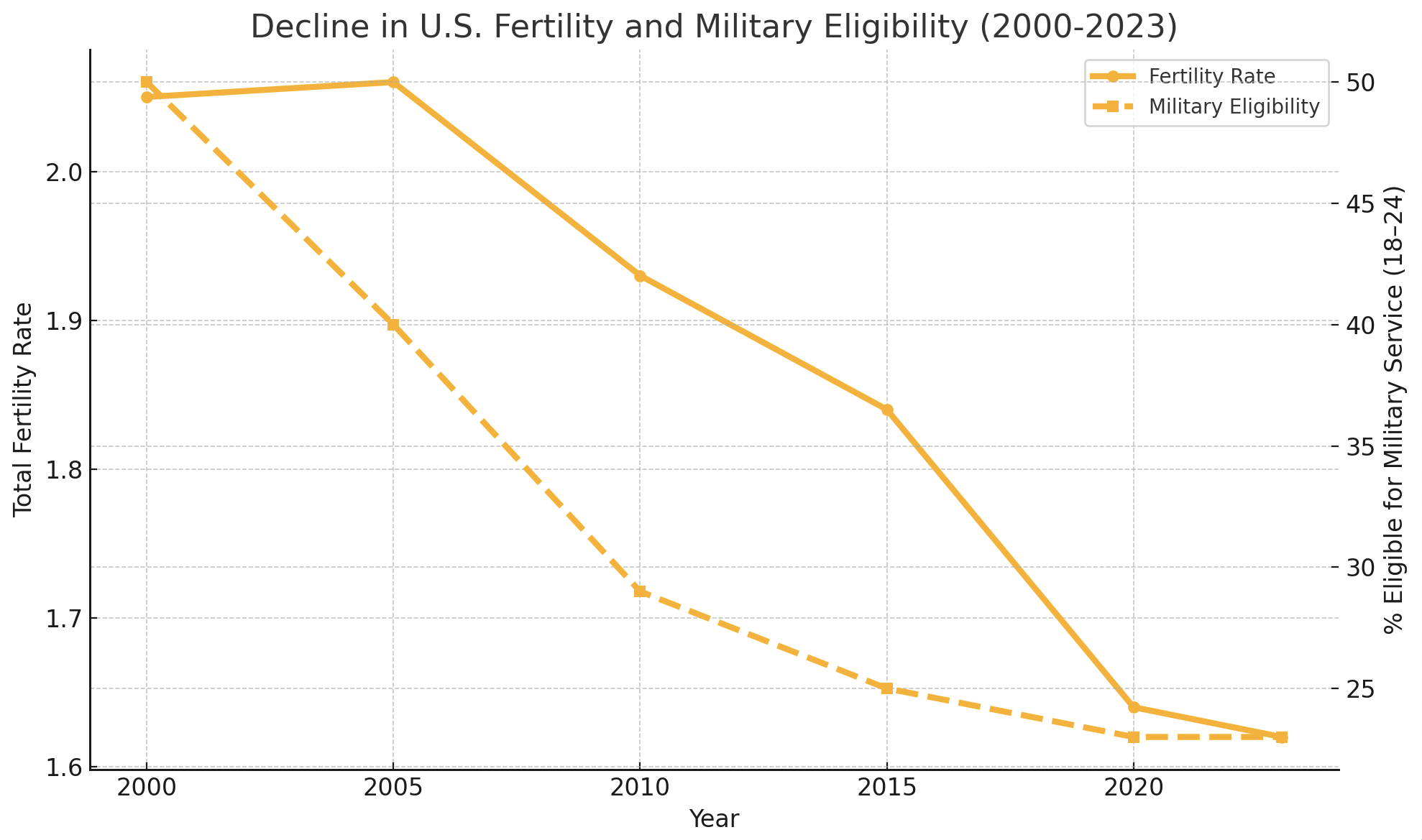— Psalm 11:3
Executive Summary
America is experiencing an accelerating internal collapse documented in CDC and DoD data—marked by demographic decline, psychological distress, and the erosion of civic cohesion—that poses a strategic threat to national security. These are not merely "domestic problems," but structural weaknesses that undermine our ability to project power, sustain economic resilience, or maintain defense readiness.
This paper proposes four immediate actions the Executive Branch can take under existing authority:
- Commission a national threat estimate from the Director of National Intelligence (DNI).
- Establish a Domestic Resilience Council (DRC), modeled on the National Security Council (NSC).
- Realign existing soft power and regulatory tools to support family formation, mental health, and community resilience.
- Hold emergency powers in reserve—available only if collapse becomes undeniable and data‑validated.
By acting now, the United States can confront internal decline with the same clarity and coordination we bring to external threats—and begin the long road to civilizational renewal.
1. Situational Assessment
The United States is entering a phase of strategic fragility not due to a single catastrophic event, but from slow, compounding failures in family structure, cultural trust, and institutional resilience.
Demographic Collapse
- U.S. fertility rate: 1.62 births per woman (2023 provisional) [CDC]
- Declining birth‑rates are not evenly distributed—native‑born Americans are falling fastest [CDC]
- In economic terms: fewer workers, fewer innovators, fewer defenders.
Mental and Physical Degradation
- 32% of adults report symptoms of anxiety or depression (2024) [CDC]
- Obesity, metabolic dysfunction, and addiction are rising across all age brackets [CDC]
- Suicide is now the 2nd leading cause of death for ages 10–34 (2022 data) [CDC]
Civic Breakdown
- Loneliness is epidemic; community participation is collapsing [HHS]
- Institutional trust has fallen to 26% average confidence (Gallup, 2024) [Gallup] across all major sectors—government, education, media, and even the military.
- A nation this fragmented becomes increasingly difficult to mobilize in crisis.
National Defense Readiness
- Only ~23% of 18–24‑year‑olds are eligible for military service [GAO]
- Recruitment targets were missed by every branch except the Marine Corps and Space Corps in FY 2023 [DoD]
- Fitness, mental health, and education shortfalls are now limiting force generation.
If these conditions were observed in a foreign country, we would classify it as unstable and potentially nearing collapse.

2. Strategic Risk
This is not a partisan crisis—it is a systemic one. The decay is affecting every domain of national strength:
A. National Security
- A brittle population base undermines long‑term force projection.
- Cultural instability breeds internal sabotage and external manipulation.
- America cannot win 21st‑century conflicts with a 21st‑century population collapse.
B. Economic Vitality
- Fewer working‑age citizens mean fewer producers and taxpayers.
- Innovation declines as institutional memory and elite cohesion break down.
- Immigration alone cannot compensate for the collapse of civic formation.
C. Strategic Vulnerability
- Adversaries like China plan generationally.
- The U.S. increasingly operates in crisis‑response mode.
- Collapse of social trust and elite competence invites asymmetric attack.
What's missing today is a strategic apparatus for understanding and addressing internal collapse the way we assess foreign threats.
Just as ISR (Intelligence, Surveillance, and Reconnaissance) evolved to track enemy movements and intent across traditional theaters, we now need a parallel framework to monitor and interpret the slow disintegration of civilizational strength. This emerging discipline—what we call Reality Science—would combine behavioral analytics, demographic intelligence, cultural signals, and institutional integrity metrics to generate a holistic picture of societal readiness.
3. Proposed Response Framework
A. Commission a "Societal Threat Estimate" by the DNI
- Directed by the President, the DNI should assess how internal demographic and institutional collapse impacts national security.
- Deliverables:
- Unclassified summary for public and interagency awareness
- Classified annex for executive and DoD planners
B. Establish a Domestic Resilience Council (DRC)
- Executive Order–established council within the Executive Office of the President.
- Membership: Heath and Human Services (HHS), Department of Defense (DoD), Education, Veteran's Administration (VA), Director of National Intelligence (DNI), and related agencies.
- Responsibilities:
- Monitor key societal indicators (fertility, trust, mental health, military eligibility).
- Publish quarterly reports on internal resilience and readiness.
- Serve as nerve center for interagency cultural and demographic strategy.
C. Redirect Existing Executive Authorities
- Grants: Prioritize funding for family formation and mental health restoration.
- Military Policy: Stabilize family life for service members, increase readiness by tackling underlying recruitment failures.
- Regulatory Reform: Accelerate review of chemicals and conditions contributing to fertility and metabolic decline.
D. Hold Emergency Powers in Reserve
- Avoid premature use of emergency declarations.
- Instead:
- Build credibility through DNI‑led estimates and DRC tracking.
- Use clear metrics to define when collapse thresholds are reached.
- Retain emergency authority only as a last resort, under the National Emergencies Act.
4. Why Now?
We are at the threshold. This is no longer speculative—it is measurable. What we choose to do next will shape the arc of the 21st century.
- Failure to act will allow cultural and strategic collapse to harden into permanence.
- Timely action can create a generational doctrine of civilizational renewal—data‑backed, morally grounded, and strategically aligned.
This isn't another task force. It's a new kind of mission. The same mindset that powered past American breakthroughs—from Apollo to the internet—must now be applied to the homefront.
We have the capacity. We need the clarity.
The old forms are collapsing. A new doctrine must be born.
Appendix: Reality Science Reference Sheet
A. What Reality Science Is Not
To be clear, Reality Science is not domestic surveillance. It does not involve spying on individuals, compiling dossiers, or monitoring private communications.
- It is not a law enforcement tool.
- It is not a tool to spy on private citizens.
- It is not an excuse for centralized overreach.
Instead, it is a strategic analysis discipline—focused on open-source data, broad indicators, institutional health metrics, and other existing or legally collectible data.
This framework mirrors how we assess the fragility or strength of foreign nations. The only difference is this: we are finally applying the same clarity and candor to ourselves.
The goal is not control.
The goal is national resilience.
Just as foreign ISR helps us avoid surprise attacks, Reality Science helps us detect internal failure before it becomes irreversible collapse.
B. Framework Overview
"Reality Science" combines behavioral analytics, demographic intelligence, cultural indicators, and elite integrity signals to generate a real‑time picture of national resilience.
Core Inputs
- Fertility and family formation
- Mental health and addiction rates
- Institutional trust and legitimacy
- Military eligibility and recruitment readiness
- Civic participation and marriage rates
Intelligence Pipeline
- Open-source data aggregation
- Behavioral analytics and trend detection
- Cross-agency signal fusion and interpretation
Primary Outputs
- National Resilience Estimate — an integrated assessment akin to a threat estimate
- Strategic Readiness Dashboard — a real-time tracking system for societal health
- Data-Driven Emergency Thresholds — pre-defined metrics for action before systemic failure
C. Collapse Metrics Dashboard
| Metric | Value & Year | National Security Risk |
|---|---|---|
| Fertility Rate | 1.62 (2023) | Population collapse |
| Military Eligibility | ~23% (2020) | Force readiness decline |
| Youth Suicide Rank | 2nd (ages 10–34) | Morale and cohesion threat |
| Trust in Institutions | 26% avg confidence (2024) | Elite legitimacy fracture |
| Marriage Rate | 6.2 per 1,000 (2022) | Collapse of family formation |
D. Executive Authority Map
| Action | Authority Source | Lead Agency |
|---|---|---|
| Societal Threat Estimate | EO / National Intel Directive | DNI |
| Domestic Resilience Council | Executive Office | WH / NSC Structure |
| Strategic Grant Redirection | OMB guidance / agency priority | Heath / Housing / Education |
| Emergency Powers (last resort) | National Emergencies Act | POTUS |
E. Pillars of Human Flourishing
As we assess the collapse, we must also clarify the aim of renewal. These six pillars represent the foundational conditions that allow individuals—and by extension, civilizations—to thrive. They are not mere preferences or lifestyle choices, but essential domains of strength that any enduring culture must protect and promote.
To restore national resilience, we must realign our systems with the principles that sustain fully human life. These are not luxuries—they are the foundation of lasting civilization.
| Pillar | Description |
|---|---|
| Faith & Meaning | A coherent worldview that provides moral grounding and existential purpose. |
| Family Formation | Stable marriages and multi‑generational households. |
| Physical Vitality | Health, fitness, and metabolic resilience rooted in strong daily habits. |
| Mental Clarity | Sanity, sobriety, and peace—free from addiction and despair. |
| Skilled Work | Purposeful labor that builds competence, character, and contribution. |
| Community Bonds | Trust networks anchored in place, history, and mutual duty. |
To flourish is not simply to survive—it is to pursue what is highest.
